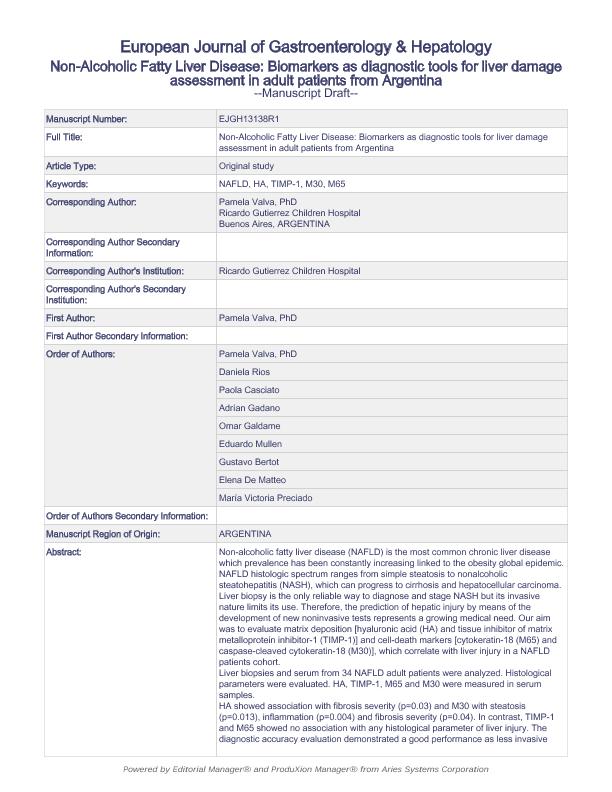Artículo
Nonalcoholic fatty liver disease: Biomarkers as diagnostic tools for liver damage assessment in adult patients from Argentina
Valva, Pamela ; Rios, Daniela Alejandra
; Rios, Daniela Alejandra ; Casciato, Paola
; Casciato, Paola ; Gadano, Adrián Carlos; Galdame, Omar; Mullen, Eduardo; Bertot, Gustavo; de Matteo, Elena Noemí
; Gadano, Adrián Carlos; Galdame, Omar; Mullen, Eduardo; Bertot, Gustavo; de Matteo, Elena Noemí ; Preciado, María Victoria
; Preciado, María Victoria
 ; Rios, Daniela Alejandra
; Rios, Daniela Alejandra ; Casciato, Paola
; Casciato, Paola ; Gadano, Adrián Carlos; Galdame, Omar; Mullen, Eduardo; Bertot, Gustavo; de Matteo, Elena Noemí
; Gadano, Adrián Carlos; Galdame, Omar; Mullen, Eduardo; Bertot, Gustavo; de Matteo, Elena Noemí ; Preciado, María Victoria
; Preciado, María Victoria
Fecha de publicación:
12/2017
Editorial:
Lippincott Williams
Revista:
European Journal Of Gastroenterology & Hepatology
ISSN:
0954-691X
Idioma:
Inglés
Tipo de recurso:
Artículo publicado
Clasificación temática:
Resumen
Background Nonalcoholic fatty liver disease (NAFLD) is the most common chronic liver disease whose prevalence has been increasing constantly and linked to the global obesity epidemic. The NAFLD histologic spectrum ranges from simple steatosis to nonalcoholic steatohepatitis (NASH), which can progress to cirrhosis and hepatocellular carcinoma. Liver biopsy is the only reliable means to diagnose and stage NASH, but its invasive nature limits its use. Therefore, the prediction of hepatic injury by means of the development of new noninvasive tests represents a growing medical need. Our aim was to evaluate matrix deposition and cell-death markers, which correlate with liver injury in an NAFLD patient cohort. Patients and methods Liver biopsies and serum from 34 NAFLD adult patients were analyzed. Histological parameters were evaluated. Matrix deposition [hyaluronic acid (HA) and tissue inhibitor of matrix metalloproteinase inhibitor-1 (TIMP-1)] and cell-death markers [cytokeratin-18 (M65) and caspase-cleaved cytokeratin-18 (M30)] were measured in serum samples. Results HA showed an association with fibrosis severity (P=0.03) and M30 with steatosis (P=0.013), inflammation (P=0.004), and fibrosis severity (P=0.04). In contrast, TIMP-1 and M65 showed no association with any histological parameter of liver injury. The evaluation of diagnostic accuracy showed good performance as less invasive markers of significant fibrosis of both HA (area under the receiver operating characteristic curve: 0.928) and M30 (area under the receiver operating characteristic curve: 0.848). Conclusion Biomarkers are essential tools that may provide a quick and accurate diagnosis for patients with life-threatening NAFLD and NASH. HA and M30, together or determined sequentially, have been found to be straightforward tests that may be sufficient to predict significant fibrosis even in a primary care center of an underdeveloped country.
Archivos asociados
Licencia
Identificadores
Colecciones
Articulos(SEDE CENTRAL)
Articulos de SEDE CENTRAL
Articulos de SEDE CENTRAL
Citación
Valva, Pamela; Rios, Daniela Alejandra; Casciato, Paola; Gadano, Adrián Carlos; Galdame, Omar; et al.; Nonalcoholic fatty liver disease: Biomarkers as diagnostic tools for liver damage assessment in adult patients from Argentina; Lippincott Williams; European Journal Of Gastroenterology & Hepatology; 30; 6; 12-2017; 637-644
Compartir
Altmétricas



